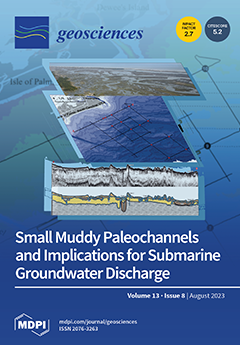Over the few past decades, the concept of microbial sulfur cycling catalyzing the precipitation of CaMg (CO
3)
2 at low temperatures (<40 °C) has been studied intensely. In this respect, two hypersaline lagoons, Lagoa Vermelha and Brejo do Espinho, in Brazil,
[...] Read more.
Over the few past decades, the concept of microbial sulfur cycling catalyzing the precipitation of CaMg (CO
3)
2 at low temperatures (<40 °C) has been studied intensely. In this respect, two hypersaline lagoons, Lagoa Vermelha and Brejo do Espinho, in Brazil, have been the subject of numerous studies investigating sedimentary Ca/Mg carbonate formation. Here, we present the sulfur and oxygen isotopic compositions of dissolved sulfate from surface water, as well as sulfate and sulfide from pore-water (δ
34S
SO4, δ
18O
SO4, and δ
34S
H2S), the sulfur isotopic composition of sedimentary pyrite (δ
34S
CRS), and sulfur and oxygen isotopic compositions of carbonate-associated sulfate (CAS, δ
34S
CAS and δ
18O
CAS). The pore-water profiles at Lagoa Vermelha indicate ongoing bacterial sulfate reduction by increasing δ
34S
SO4, δ
18O
SO4 and δ
34S
CRS values downcore. At Brejo do Espinho, the pore-water profiles displayed no depth-dependent isotope trends; the Ca/Mg ratio was, on average, lower, and the δ
18O
SO4 values in both surface and pore-water were strongly enriched in
18O. There was an overall mismatch between δ
34S
SO4 and the significantly higher δ
34S
CAS values. A negative correlation was observed between the Ca/Mg ratio and higher δ
34S
CAS values. The results show that the size difference between the two lagoons induces differences in the intensity of evaporation, which leads to the increased secretion of extrapolymeric substances (EPSs) by microbes in the smaller Brejo do Espinho. EPS provides the microenvironment where Ca/Mg carbonate can nucleate and preserve increased δ
34S
CAS values. Apart from EPS, increased sulfur oxidation is proposed to be a second factor causing relative enrichment of Ca/Mg carbonates at Brejo do Espinho. Our results emphasize the role of evaporative processes on Ca/Mg carbonate formation, and indicate that the respective δ
34S
CAS values reflect microenvironments rather than preserving an open marine δ
34S
SO4 signature.
Full article
 to open them.
to open them.




